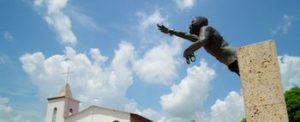
Statue (town square)
*The founding of Palenque de San Basilio is celebrated on this date in 1691. This was the first established African town in Columbia.
San Basilio de Palenque or Palenque de San Basilio is a Palenque village and corregimiento and is located in Mahates, Bolivar in northern Colombia. Palenque is also considered one of the first free African towns in the Americas. During the Middle Passage, Spaniards introduced kidnapped African slaves to South America through the Magdalena River Valley. Its mouth is close to the important port of Cartagena de Indias, where ships full of Africans arrived.
Some Africans escaped and set up Palenque de San Basilio, a town near Cartagena. They tried to free all African slaves arriving at Cartagena and were quite successful. Therefore, the Spanish Crown issued a Royal Decree (1691) guaranteeing freedom to the Palenque de San Basilio Africans if they stopped welcoming New escapees.
Palenque de San Basilio's village has about 3,500 inhabitants and is located in the foothills of the Montes de María, southeast of Cartagena's regional capital. The word "palenque" means "walled city." The Palenque de San Basilio is only one of many walled communities founded by escaped slaves as a refuge in the seventeenth century. Of the many palenques of escaped slaves that existed previously, San Basilio is the only one that survives. Many oral and musical traditions have roots in Palenque's African past. Africans were kidnapped to Spanish America under the asiento system.
The village of San Basilio is inhabited mainly by Afro Colombians, who are direct descendants of African slaves brought by the Europeans during the invasion of the Americas. They have preserved their ancestral traditions and developed their language, Palenquero. In 2005, the Palenque de San Basilio village was proclaimed a Masterpiece of the Oral and Intangible Heritage of Humanity by UNESCO. In the Palenque de San Basilio village, most of its inhabitants are Black and still preserve customs and language from their African ancestors. In recent years, people of indigenous ancestry have settled at the borders of Palenque, having been displaced earlier by the Colombian Civil War. Benkos Bioho established the village sometime in the 16th century.
A Spanish-based Creole language known as Palenquero originates in this community. The New York Times reported on October 18, 2007, that the language spoken in Palenquero is thought to be the only Spanish-based Creole language spoken in Latin America. As a Creole language, its grammar differs substantially from Spanish, making it unintelligible to Spanish speakers. Palenquero was influenced by the Kikongo language of Congo and Angola, and Portuguese, the language of the slave traders who brought African slaves to South America in the 17th century.
Exact information on Palenquero's different roots is still lacking, and there are different theories of its origin. Fewer than half of the community’s 3,000 residents still speak Palenquero. A linguist born in Palenquero compiles a lexicon for the language, and others assemble a dictionary of Palenquero. The defenders of Palenquero continue working to keep the language alive.